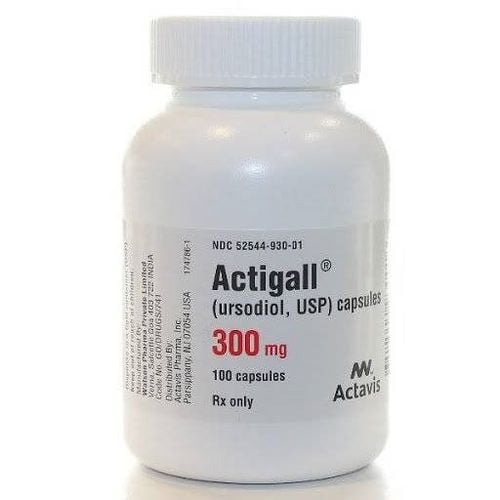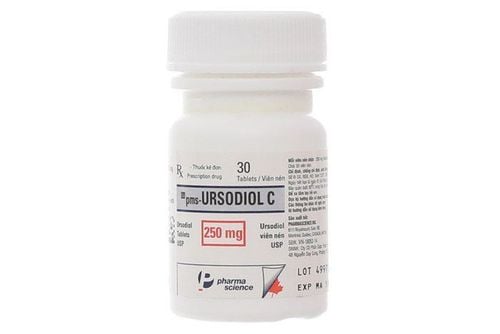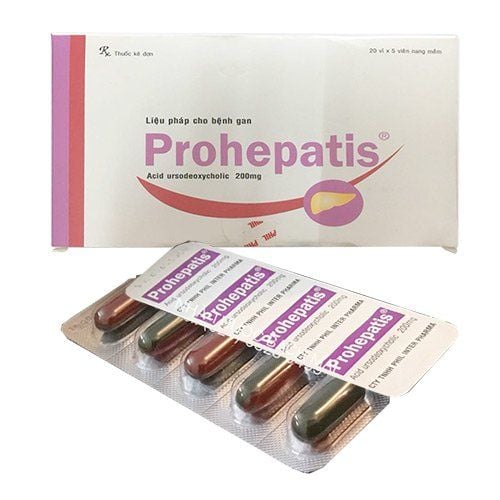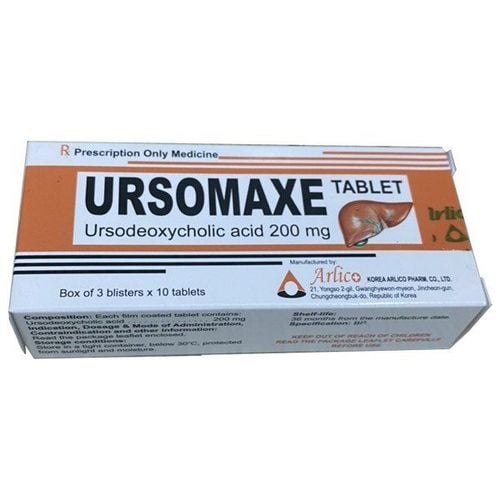This is an automatically translated article.
Urdoc drug is a drug to dissolve cholesterol gallstones in patients with active gallbladder, treat primary biliary cirrhosis, cholecystitis, biliary tract inflammation,... effectively. On the market today, there is a lot of information about urdoc drug products, but it is still incomplete. To better understand what urdoc 100mg and urdoc 300mg are, what are the uses of urdoc, let's learn more in the article below.
1. What is Urdoc drug?
Urdoc has the main ingredient is ursodeoxycholic acid, which belongs to the group of drugs known as biliary drugs, dissolve gallstones and protect the liver. The drug is prepared in the form of tablets of 100mg, 300mg, 450mg depending on the needs of use. Urdoc is a product of Agimexpharm Pharmaceutical Company - Vietnam. What is Urdoc 100mg drug: Urdoc 100mg is a drug that dissolves cholesterol gallstones in patients with active gallbladder, treating primary biliary cirrhosis, cholecystitis, biliary tract inflammation,... effectively. With the ingredients contained in the medicine, it will help patients regain stable health soon. Urdoc 100mg is a product of Agimexpharm company. Ingredients of Urdoc 100mg: Ursodeoxycholic Acid 100mg. Dosage form Tablets. What is Urdoc 300mg drug: Ingredients in Urdoc 300mg include: Ursodeoxycholic acid 300mg. The main active ingredient in Urdoc is ursodeoxycholic acid with the mechanism of action of promoting bile secretion, inhibiting bile reabsorption in the intestine, thereby reducing bile acids in the blood. Besides, it also helps to reduce cholesterol in bile, increase the conversion of cholesterol into bile acids, thereby preventing stone formation and dissolving cholesterol gallstones. Urdoc tablets are often prescribed by doctors in the following cases:Treatment of primary biliary cirrhosis (PBC), dissolving cholesterol-rich gallstones, small to medium-sized radioactive substances in patients have a functioning gallbladder. Calcium-coated cholesterol stones or stones with bile pigments that are not dissolved by ursodeoxycholic acid. Dissolution of cholesterol gallstones in patients with an active gallbladder. Primary biliary cirrhosis. Improve liver function in chronic hepatitis. Protect and restore liver cells before or after drinking alcohol. Indigestion, loss of appetite due to disorders in the biliary tract. Support the treatment of cholecystitis, inflammation of the biliary tract. Urdoc has a special place in the treatment of patients who are contraindicated for stone removal surgery or who are psychologically overly anxious to avoid surgery. For children: Urdoc is indicated in the treatment of hepatobiliary disorders associated with cystic fibrosis in children from 6 years old to under 18 years old.
2. What are the uses of Urdoc 300mg and Urdoc 100mg?
2.1. Pharmacodynamic properties When administered orally, ursodeoxycholic acid reduces the ratio of cholesterol and phospholipids in bile and bile salts, causing cholesterol desaturation of bile. Urdox's exact mechanism of action has not yet been fully elucidated.
Cystic fibrosis: From clinical reports, long-term experience of up to 10 years and more is available with the treatment of patients with cholestatic jaundice (ursodeoxycholic acid - UCDA) in pediatric patients with liver disorders. cystic fibrosis-associated bile duct (CFAHD). There is evidence that treatment with UCDA can reduce bile duct proliferation, prevent the progression of histological damage, and even reverse bile and hepatic changes if performed in the early stages of cystic fibrosis. . Treatment with UDCA should be initiated as soon as a diagnosis of cystic fibrosis is made to optimize treatment efficacy.
2.2. Pharmacokinetic properties Ursodeoxycholic acid is absorbed from the gastrointestinal tract and undergoes first-pass metabolism and enterohepatic recycling. It is partially conjugated in the liver before being excreted in the bile and undergoing 7-α-dehydroxylation to lithocholic acid, some of which is excreted directly in the feces. The remainder is absorbed and is mainly conjugated and sulfated by the liver before being excreted in the feces.
2.3. Contraindications of Urdoc 300mg and Urdoc 100mg Urdoc should not be used in patients who:
* Adults:
Calcified gallstones that are opaque, Acute cholecystitis or biliary tract disease. Biliary obstruction (obstruction of the common bile duct or a cystic duct) Frequent episodes of biliary colic Decreased contractility of the gallbladder insufficiency Hypersensitivity to bile acids or any of the excipients of the formulation Pregnant or nursing women breastfeeding, or women who may become pregnant. Chronic liver disease, peptic ulcer or people with inflammatory diseases of the small intestine and colon. * Children:
Intussusception surgery failed or failed to restore good bile flow in children with biliary hypoplasia
2.4. Interactions with other medicinal products Ursodeoxycholic acid should not be taken concomitantly with activated charcoal, colestyramine, colestipol, or antacids containing aluminum hydroxide and/or smectite (aluminum oxide), as these preparations bind to ursodeoxycholic acid. in the intestine and thereby inhibiting its absorption and efficacy. If the use of a preparation containing one of these substances is necessary, it must be taken at least 2 hours before or after the administration of ursodeoxycholic acid. Active ingredient Ursodeoxycholic acid in Urboc may increase the absorption of ciclosporin from the gut. In patients being treated with cyclosporin, the physician should therefore check blood levels of this substance and adjust the dose of cyclosporin if necessary. In isolated cases, the active ingredient ursodeoxycholic acid in Urboc may reduce the absorption of ciprofloxacin. Ursodeoxycholic acid has been shown to reduce the peak plasma concentrations (C max) and area under the curve (AUC) of the calcium antagonist nitrendipine. Interactions with a decrease in the therapeutic effect of dapsone have also been reported. These observations together with the in vitro findings may indicate the ability of ursodeoxycholic acid to induce cytochrome P450 3A enzymes. However, controlled clinical trials have shown that ursodeoxycholic acid has no inducible effects related to cytochrome P450 3A enzymes. Oral contraceptives, allergy hormones, and cholesterol-lowering agents such as clofibrate can increase gallstones, which is counterproductive to ursodeoxycholic acid, which is used to dissolve gallstones without surgery.
2.5. Side effects of Urdoc 300mg and Urdoc 100mg Gastrointestinal disorders:
In clinical trials, reports of loose stools or diarrhea during treatment with ursodeoxycholic acid were common.
Very rarely, severe right upper abdominal pain occurs during the treatment of primary biliary cirrhosis.
Ursodeoxycholic acid can cause nausea and vomiting. The frequency of these effects is not known.
Hepatobiliary disorders :
During ursodeoxycholic acid treatment, calcification of gallstones may occur in very rare cases rendering them insoluble by bile acid therapy and leading to some The patient has to have surgery.
During the treatment of advanced stages of primary biliary cirrhosis, in very rare cases decompensated cirrhosis has been observed, which partially regresses after cessation of therapy.
Skin and subcutaneous disorders :
Very rarely, urticaria may occur. Ursodeoxycholic acid may cause itching.
2.6. Special warnings and precautions when using Urdoc 300mg and Urdoc 100mg Ursodeoxycholic acid should be taken under medical supervision.
During the first 3 months of treatment, liver function parameters ALT (SGPT), AST (SGOT) and γ-GT should be monitored by the doctor every 4 weeks, then every 3 months. In addition to allowing for the identification of responders and non-responders in patients being treated for primary biliary cirrhosis, this monitoring also allows early detection of liver deterioration, particularly in patients with cirrhosis. severe primary hepatobiliary disease.
* When used to dissolve cholesterol gallstones:
To assess treatment progress and promptly detect any calcifications of gallstones, depending on stone size, gallbladder imaging (photography) is recommended. gallbladder) with an overview and obstruction in the standing and supine position (ultrasound control) 6-10 months after initiation of treatment. If the gallbladder cannot be seen on x-ray, or in the case of calcified gallstones, impaired contractility of the gallbladder, or frequent biliary colic, ursodeoxycholic acid should not be used. * When used to treat advanced stages of primary biliary cirrhosis:
In the very rare cases where decompensated cirrhosis has been observed, the disease is partially regressive after treatment is discontinued. If diarrhea occurs, the dose should be reduced and in the case of persistent diarrhea, treatment should be discontinued and an alternative treatment sought. Patients with rare hereditary problems of lactose deficiency, galactose intolerance, or glucose-galactose malabsorption should not take Urdoc.
3. How to use Urdoc effectively
3.1. Dosage of Urdoc 300mg and Urdoc 100mg Dosage should be calculated based on the patient's body weight. The calculated dosage should be rounded to the nearest number of tablets.
* Dissolve cholesterol stones
Usual dosage: 8 to 10 mg/kg/day, which corresponds to, for example, four to six 150mg tablets, or two to three 300mg tablets, or two 450mg tablets. The daily dose may be taken two or three times after meals: two tablets should be taken after the evening meal.
It is also possible to choose a single dose in the evening (eg, a 60kg patient, in the evening two 300mg tablets). Preferably, this single dose should be taken one hour before bedtime and ± two hours after dinner with a glass of milk or a snack.
The length of treatment to separate gallstones depends on their size, but is usually not shorter than three to four months. To accurately assess the outcome of therapy, it is necessary to accurately determine the size of the stone at the beginning of treatment and check this more often, for example every six months, by recording X-rays. new contrast or ultrasound recording.
Patients who have not decreased in size after six months of treatment with the prescribed dose should determine the gallstone index in bile by duodenal drainage. When bile has a score of >1.0, favorable results are unlikely, and it is better to consider another form of gallstone treatment.
Treatment should be continued for three to four months after being established by using ultrasound to check if the gallstones have completely dissolved. Discontinuing treatment for three to four weeks resulted in a return of bile to supersaturation and prolongation of the overall duration of treatment. Discontinuation of treatment after dissolution of gallstones may result in recurrence.
* Primary cholangitis
Dosage of Urboc in primary cholangitis (stages I-III), up to 12-15 mg/kg/day, equivalent to four to eight 150mg tablets, two to four 300mg tablets, taken in two to three parts during the day, or with two 450mg tablets, taken in two parts during the day.
The dose of Urboc in primary cholangitis stage IV and elevation of serum bilirubin (>40 μg/l), in the first case, is only half of the normal dose (6 to 8 mg/L). kg/day). Thereafter, liver function should be closely monitored for liver dysfunction for several weeks (every two weeks for six weeks). If there is no impairment of liver function (ALT (SGPT), AST (SGOT), AF, γ-GT, bilirubin) and no pruritus occurs, the dose can be increased further to the normal range. Furthermore, liver function must again be closely monitored for several weeks. If liver function is not impaired again, the patient can be kept at the normal dosage for a long time.
In patients with stage IV primary cholangitis without elevated serum bilirubin, the usual starting dose is allowed to be administered directly. Anyway, here it is also advisable to exercise precise control of liver function.
The treatment of primary cholangitis should be regularly evaluated on the basis of proximal (laboratory) values and clinical findings.
* Children
Children with cystic fibrosis from 6 years old to 18 years old
Treatment of hepatobiliary diseases caused by cystic fibrosis 20 mg / kg / day divided into two to three times. If necessary, increase to 30 mg/kg/day. This corresponds to four to ten 150mg tablets, two to five 300mg tablets, or to two to three 450mg tablets, taken in one or two servings a day.
* Urdoc drug treatment
If the patient has difficulty swallowing due to the size of the tablet, the tablet can be halved if necessary on the dividing line, so that half of the tablet can be taken twice directly according to the schedule. on one's own.
3.2. Overdose when using Urdoc 300mg and Urdoc 100mg Diarrhea can occur in case of overdose. In general, other symptoms of overdose are unlikely because the absorption of ursodeoxycholic acid decreases with increasing dose and therefore more is excreted in the feces.
No specific countermeasures are necessary and the consequences of diarrhea should be treated symptomatically by restoring water and electrolyte balance.
Please dial HOTLINE for more information or register for an appointment HERE. Download MyVinmec app to make appointments faster and to manage your bookings easily.













